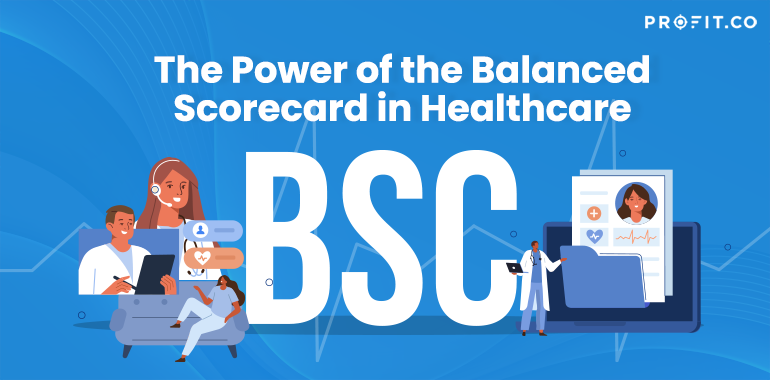The Balanced Scorecard (BSC) is a strategic tool designed to offer a panoramic view of the healthcare landscape, ensuring alignment and facilitating progress tracking with unmatched precision. Imagine a navigational tool that transcends financial metrics, empowering you to enhance patient satisfaction, optimize operational workflows, and nurture your team’s development. The BSC is your organizational GPS, spotlighting your current position and charting a course toward a thriving future.
“A mere 7% of employees today fully understand their company’s business strategies and what’s expected of them in order to help achieve company goals.”
Why the Balanced Scorecard Matters in Healthcare?
- Healthcare’s fast-paced and regulatory-heavy landscape requires a sophisticated performance management approach.
- The BSC extends the focus beyond financial outcomes to include key areas critical to healthcare success.
- Emphasizes the importance of patient satisfaction as a core component of healthcare delivery.
- Targets improvements in operational efficiency to better serve patients and streamline processes.
- Encourages an ongoing commitment to enhancement and innovation within healthcare organizations.
- Provides a strategic framework to help healthcare entities excel in a highly competitive environment.
The Power of Four Perspectives
The BSC incorporates four interconnected perspectives:
- Financial
Assessing financial health and sustainability through revenue, profitability, and resource utilization. - Customer
Measuring patient satisfaction, experience, and access to quality care. - Internal Processes
Evaluating the efficiency and effectiveness of core healthcare processes. - Learning & Growth
Focusing on staff development, innovation, and knowledge sharing to drive continuous improvement.
By considering these interconnected perspectives, healthcare organizations comprehensively understand their performance and can optimize decision-making across all levels.

The Balanced Scorecard in Action
Balanced Scorecard framework for the healthcare sector strategically aligns organizational objectives with actionable initiatives, focusing on financial stewardship, patient-centered care, operational excellence, and staff’s continuous growth and development. It’s designed to navigate and lead in the dynamic healthcare environment, ensuring that every strategic effort contributes directly to overarching goals of quality care, efficiency, and innovation.
Consider the scenario of a prominent healthcare institution facing challenges in maintaining operational efficiency and patient satisfaction amidst growing competition. Despite having a solid foundation in performance management, the lack of a unified strategy and measurable objectives led to fragmented efforts and suboptimal outcomes.
The solution to the challenge is to implement the Balanced Scorecard, adapting it to fit the unique needs of the healthcare environment.
Ready to start your BSC journey today?
The BSC framework for the Healthcare Institution was customized to include:
| Perspective | Objective | Key Results | Initiatives |
|---|---|---|---|
| Financial | Reduce operational costs by 10% | 5% reduction in supply expenses | Implement lean management practices |
| – | 5% increase in outpatient services revenue | Expand outpatient services | |
| Patient Satisfaction | Achieve 95% patient satisfaction rate | Decrease patient waiting time by 20% | Optimize appointment scheduling system |
| – | Increase patient safety incidents reporting | Implement a patient feedback mechanism | |
| Internal Processes | Streamline patient admission and discharge | 15% reduction in average length of stay | Automate patient records management |
| Improve clinical care processes | 10% reduction in hospital readmissions | Introduce clinical pathways | |
| Learning and Growth | Enhance staff competency and satisfaction | 20% increase in staff training participation | Launch a continuous education program |
| Implement cutting-edge healthcare technology | 30% increase in the use of digital health records | Adopt new health information systems |
Positive Outcomes
- Unified strategy leading to improved operational efficiency.
- Patient satisfaction scores soared, leading to increased patient loyalty and referrals.
- Streamlined processes improved efficiency, reducing costs and wait times.
- Staff engagement and knowledge management boosted quality of care and innovation.
- Improved financial performance allowed reinvestment in key areas.
Challenges
- Initial resistance to change.
- The complexity of integrating new technologies.
Overcoming Common Challenges
Implementing the BSC is not without its hurdles. Resistance to change is a frequent obstacle, often stemming from a lack of understanding or fear of increased workload. Successful adoption requires comprehensive training and clear communication about the BSC’s benefits. Technological integration, another challenge, can be streamlined by leveraging modern software solutions that automate data collection and analysis, making the BSC more accessible and less burdensome.
Leveraging Technology
The digital revolution in healthcare offers unprecedented opportunities to enhance the Balanced Scorecard. Advanced analytics and AI can provide deeper insights into patient satisfaction and operational efficiency, while Electronic Health Records (EHR) integration ensures that patient care metrics are accurately captured and assessed. This technological synergy not only simplifies the implementation of the BSC but also enriches the quality of the data it relies upon.
A Glimpse into the Future
Looking ahead, the BSC in healthcare is set to evolve further, incorporating emerging metrics focused on patient-centric care, sustainability, and digital health innovations. As healthcare organizations strive towards more holistic and sustainable models of care, the BSC will continue to adapt, ensuring that strategic objectives remain aligned with the broader vision of health equity and environmental stewardship.
Real-world examples of Balanced Scorecard (BSC)
Implementing real-world examples of Balanced Scorecard (BSC) applications in healthcare can provide tangible evidence of its impact.
The Mayo Clinic
Known for its excellence in patient care, The Mayo Clinic has effectively utilized the BSC to maintain its leadership position and continue its goal of providing the best care to every patient.
Implementation:
The Mayo Clinic’s BSC approach integrates patient care, research, and education, focusing on patient satisfaction, operational effectiveness, staff engagement, and financial stability.
Outcomes:
- Research and Education: By balancing its focus between patient care and its research/education missions, The Mayo Clinic has continued to innovate in medical treatments and practices.
- Patient Care: The clinic has consistently ranked high in national patient satisfaction surveys, attributing part of its success to the strategic focus guided by the BSC.
- Financial Stability: Despite the challenges in healthcare, The Mayo Clinic has maintained financial health, enabling reinvestment in facilities, technology, and research.
This example demonstrates the Balanced Scorecard’s utility in driving comprehensive improvements in healthcare organizations. By focusing on a balanced set of objectives, this institution has enhanced its operational, financial, and clinical performance, underscoring the BSC’s value in the complex healthcare environment.
Elevating Strategy with OKRs
Aligning the BSC with Objectives and Key Results (OKRs) can further streamline strategic execution. OKRs offer agility and clarity, making them an excellent complement to the BSC’s structured approach. Healthcare organizations can ensure that every department’s efforts contribute to the overarching goals by setting clear objectives and measurable key results.
A Strategic Blueprint for Healthcare Excellence
The Balanced Scorecard, especially when combined with OKRs, provides a robust framework for healthcare organizations to navigate the complexities of modern healthcare delivery. This strategic integration fosters operational agility and ensures a culture of continuous improvement, driving healthcare organizations toward a future where quality care and operational excellence are inextricably linked. Balanced Scorecard Software can further enhance this framework by providing real-time data, seamless integration with existing systems, and advanced analytics capabilities.
To learn more about the Balanced Scorecard
Related Articles
-
Why Strategic Planning Is the Foundation of High-Performance Organizations
Strategic planning encompasses an organization's goals, objectives, and values, providing clear guidelines to identify and resolve issues effectively. Successful organizations... Read more
-
Matrix Management: Benefits, Challenges, and Best Practices
Matrix management simplifies workflow management, ensuring flexible decision-making while eliminating barriers and silos across cross-functional teams. A company’s management structure... Read more
-
How the Interplay Between Planning, Processes, and People Drives High Performance
High performance doesn’t happen by chance. It’s the product of deliberate strategy, flawless execution, and empowered people working in harmony.... Read more
-
Burn, Turn, Churn: Will your business end up in an urn?
Bastin Gerald Founder & CEO at Profit.co Last updated: April 8, 2025 Urns are traditionally used to store the ashes... Read more

